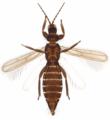Dactuliothrips boharti
Recognition data
Distinguishing features
Both sexes fully winged. Body, legs and antennae dark brown, except pedicel of antennal segment III; fore wings strongly shaded except near base. Antennae 9-segmented, segment IX longer than VIII; segments III–IV each with two oval sensoria. Head relatively long with 3 pairs of long postocular setae. Pronotum with many prominent setae, about 4 pairs on anterior margin and 5 pairs on posterior margin. Mesonotum with many microtrichia. Metanotum with only one pair of setae, sculpture arcuate around anterior margin and with many microtrichia. Fore femur with 4–9 short broad setae on inner margin. Fore tarsal hamus recurved. Fore wing broad with apex rounded. Abdominal tergites with transverse lines of sculpture. Sternites IV–VI with 3 pairs of marginal setae and up to 10 discal setae in a transverse row, completely covered with microtrichia; sternite VII with about 5 pairs of lateral discal setae and 2 pairs of supernumerary setae sub-medially.
Male abdominal tergite I with paired longitudinal ridges not reaching anterior margin, sternites without discal setae.
Related and similar species
Currently there are six species described in the genus Dactuliothrips, of which four are from California and two from Argentina.
Taxonomic data
Current valid name
Dactuliothrips boharti Bailey
Original name and synonyms
- Dactuliothrips boharti Bailey, 1937: 122
Family placement
Aeolothripidae
Biological data
Life History
Presumably breeding in flowers, with adults having been collected from flowers of various plants. This species is reported to be abundant in early spring in California (Bailey, 1957).
Host plants
Yucca brevifolia (Agavaceae)
Tospoviruses vectored
None
Crop damage
None
Distribution data
Area of origin
Western USA
Distribution
California









